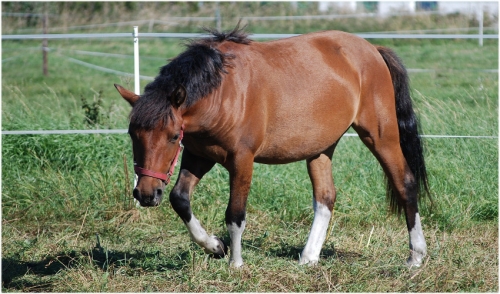
5 Steps to Stop Your Horse From Pawing
There are many reasons why a horse may be pawing at the ground – it may be bored or restless, playful, anxious, stressed or simply seeking attention – but once you understand why your horse is pawing, you can take simple steps to stop the undesirable behavior.
Why Pawing Is Bad
Pawing may seem like innocent behavior, but excessive pawing can indicate greater problems such as emotional upsets, hoof injuries or leg pain that needs to be tended to. Overzealous pawing can also create problems, causing hoof wear that could lead to lameness or other injuries, or damaging fences, trailers or stalls. If your horse starts pawing, it is essential to quickly discourage the behavior.
Why Is Your Horse Pawing?
The first – and most important – step to stop your horse from pawing is to determine why the horse paws. Different reasons include…
- Emotional stress or disturbances
- Foot issues such as discomfort or injury
- Distressing ground condition
- Nearby activities that disturb the horse
- Inadequate space that causes frustration
- Boredom and a desire for activity or attention
Watch your horse carefully when it is pawing, noting when it starts and stops the behavior as well as any changes in the pawing, such as more exaggerated motions or stronger kicks. Once you have determined why the horse is pawing, you can move forward with discouraging excessive pawing.
Stop Your Horse From Pawing
There are several ways to help stop your horse from pawing, depending on why it is agitated. If the exact cause is unclear, using several of these techniques can minimize pawing behaviors.
- Adjust Surrounding Conditions
Many horses paw because something nearby is disturbing them, and if you remove that disturbance, the behavior will stop. It may be something as simple as an uneven board in the stall that the horse is pawing at, or it may be a view the horse has of activities it wishes to join and changing their stall could reduce that anxiety.
- Tend to the Horse's Stance
A sore leg or foot, poor posture or uneven ground could all lead to pawing from an uncomfortable horse. Watch how the horse stands while it is pawing, and check its legs, feet and hooves carefully for any signs of bruising, swelling or infections that could be causing discomfort. If the ground is uneven, add boards or bedding that can make the area more comfortable for standing.
- Use Reward Training
Many horses start pawing when they want attention, and if you immediately go over to a pawing horse, they believe they have taught you a trick and will manipulate you with pawing. Instead, ignore when the horse starts pawing, but pay attention to the horse when it stops. Offer rewards such as food or attention for stopping pawing and the horse will soon learn what behavior is and is not acceptable.
- Stay Positive
It does take patience to keep a horse from pawing, and if you yell at or otherwise punish your horse for pawing, you will just create more anxiety and frustration for both you and the horse, which will increase the pawing behavior. Stay positive and reinforce good behavior rather than acknowledging bad actions, and the pawing should diminish.
Pawing behavior can be stopped, once you understand why your horse is pawing and take the proper steps to mitigate the behavior.


